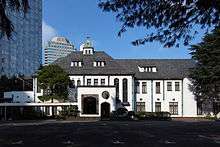Grand Prince Hotel Akasaka
| Grand Prince Hotel Akasaka | |
|---|---|
 | |
| General information | |
| Coordinates | 35°40′48″N 139°44′14″E / 35.6798825°N 139.7372472°ECoordinates: 35°40′48″N 139°44′14″E / 35.6798825°N 139.7372472°E |
| Completed | 1982 (new tower) |
| Opening | 1955 |
The Grand Prince Hotel Akasaka (グランドプリンスホテル赤坂 Gurando Purinsu Hoteru Akasaka) was an upscale hotel in Chiyoda, Tokyo, Japan. The site of the former hotel is now the location of a mixed-use development named Tokyo Garden Terrace.
A design of leading Japanese architect Kenzo Tange, the hotel was well known for its "distinctive saw-toothed facade" of aluminium and glass.[1] Following closure it became notable for being deconstructed in a top-down approach, the building appearing to shrink in height over time.
History

The original hotel, opened in 1955, was located in the Kitashirakawa Palace, built in 1930 as the residence of Yi Un, the last crown prince of Korea. The newer tower building designed by architect Kenzo Tange and completed in 1982 was 40 storeys tall and laminated in aluminium. Because of its proximity to Nagatachō Station and the National Diet buildings, it was often used by Japanese politicians for meetings and press conferences.
For most of its life, the hotel operated as the Akasaka Prince Hotel, but in 2007 the hotel was renamed Grand Prince Hotel Akasaka following the reorganization of the Prince hotel group.
When its closure was scheduled, Akasaka Prince Hotel tower was relatively new, being expected to last further decades with proper maintenance and renovation, it was one of the buildings that "fell victim to the vagaries of commercial real estate here, where high property values, changing design standards and other factors have conspired to create a bull market for demolition".[1] It had low ceilings like many office contemporaries built in the 1970s during the country's economic boom (height standards were increased in the 1990s to accommodate information technology infrastructure). In recent years it faced competition from upscale hotels run by foreign companies.[1]
Although it closed as a hotel in March 2011, after the 2011 Tōhoku earthquake and tsunami, the Akasaka Prince Hotel housed evacuees from Fukushima prefecture.[2]
The hotel closed in March 2011 for demolition.[3]
The top floors of the building were used as a working space for deconstruction, and these are gradually jacked down and lowered as each intermediate floor is removed. As of February 2013 the building had shrunk by 30 metres.[4] Regenerative braking is used on the cranes being used to lower disassembled elements down to ground level, which recovers energy and generates electricity for powering aspects of the demolition operation.[5]
The hotel was replaced by the Tokyo Garden Terrace development, but the historic Kitashirakawa Palace, original home of the hotel, was restored and reopened in 2016 as a function center for banquets and weddings, known as Akasaka Prince Classic House.
-

The hotel in 2007
-

The hotel in 2007
See also
References
- 1 2 3 Fountain, Henry (17 June 2013). "Tricky Ways to Pull Down a Skyscraper". The New York Times.
- ↑ Fukue, Natsuko (25 March 2011). "Prince hotel spared wrecking ball to house evacuees". The Japan Times.
- ↑ 赤坂プリンス、来年3月末閉館 新館は取り壊しへ. Asahi Shimbun (in Japanese). The Asahi Shimbun Company. 28 April 2010. Retrieved 28 April 2010.
- ↑ Wingfield-Hayes, Rupert (11 February 2013). "Japan's incredible shrinking building" (video). BBC News Online. Japan. Retrieved 11 February 2013.
- ↑ Kazuaki Nagata (8 January 2013). "Razing skyscrapers from the inside". The Japan Times. Retrieved 11 February 2013.